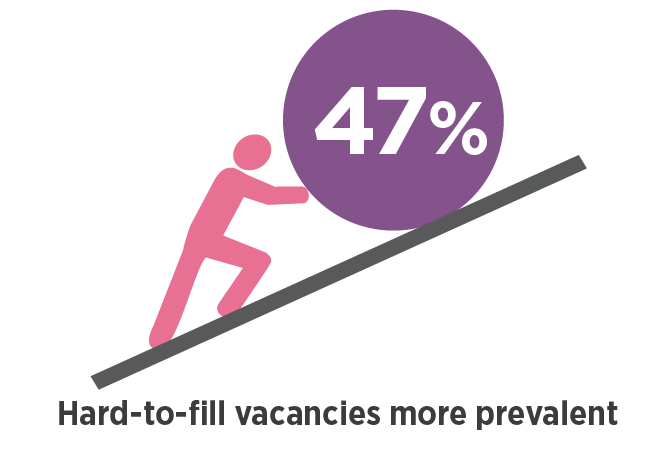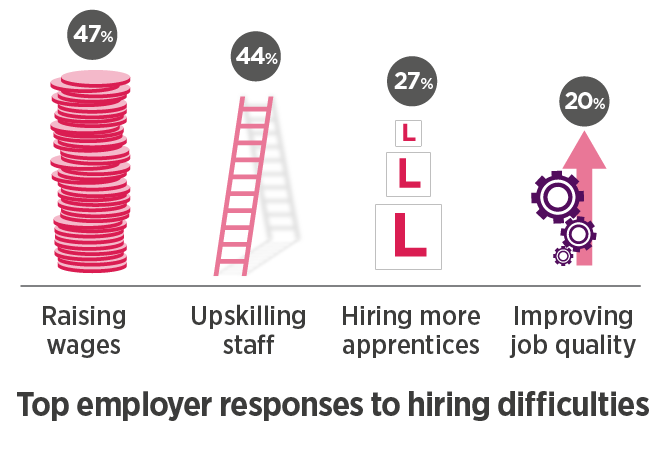The CIPD’s latest study has revealed the top tactics that employers are using to combat the ongoing talent shortages.
Almost half (47%) have raised wages over the past six months to help offset hard-to-fill vacancies. Other popular tactics include upskilling existing staff (44%), hiring more apprentices (27%) and improving job quality (20%). Companies have adopted some of these tactics to ease the current recruitment difficulties.
Almost half (47%) of employers report having vacancies that are hard-to-fill; and more than one in four (27%) expect the number of vacancies that are difficult to fill to increase in the next six months, according to the professional body for HR and people development. These findings are the latest quarterly CIPD Labour Market Outlook (LMO), which surveyed more than 1,000 employers across all sectors of the economy. Employers were surveyed about their hiring, pay and redundancy intentions for the last quarter of 2021 in September; just as the furlough scheme was ending.

JUMP IN HARD-TO-FILL VACANCIES
The proportion of employers with hard-to-fill vacancies jumped from 39% to 47% this quarter; and hard-to-fill vacancies are most prevalent in construction, healthcare and public administration and defence. Nearly three quarters (71%) of employers surveyed are planning to recruit in the three months to December 2021; with intentions at their highest since the onset of the Covid-19 pandemic.
Around 10% employers are planning to make redundancies, down from 13% last quarter. This is the latest indication that the end of the furlough scheme will not lead to widespread redundancies, as originally predicted, the report noted. The continued uptick in recruitment, paired with another modest fall in redundancy intentions amid continued labour shortages suggests there will be further difficulties for employers in the coming months.
“Employers have a challenging few months ahead with many anticipating increased recruitment difficulties. On the upside, it’s positive to see that some employers are getting better at sourcing labour by taking steps to improve how they recruit, retain and train staff. However, there’s a relatively long tail of employers who could be doing more to attract and make full use of available workers,” stated Gerwyn Davies, Senior Labour Market Adviser for the CIPD. “More business support is required from government to help employers increase their capability to invest in skills; and create better quality and more productive jobs. This is essential if the UK economy has any hope of transitioning to a high-skill, high wage economy”.

YOUTH SCHEME TO EASE RECRUITMENT CHALLENGES
According to the CIPD report, the rapid expansion in hiring activity, coinciding with a fall in labour supply underlines the need for a temporary job mobility scheme for young EU nationals. This would build on the current Youth Mobility Scheme meaning it could be quickly introduced to help counter some of the shortages; particularly for low-skilled roles that are proving more difficult to fill. On average, employers received 16 applicants for the last low-skilled vacancy they tried to fill; compared with 20 applicants last quarter, highlighting the challenge of reduced labour supply.
“The research findings strengthen the case for extending the existing Youth Mobility Scheme,” highlighted Davies. “This would prove a timely, cheap and effective ‘safety valve’ to help ease immediate labour shortages. Meanwhile, reforming the Apprenticeship Levy into a broader, more flexible training levy would give employers the opportunity to use a wider range of qualifications that are more relevant for hard-to fill roles. Key examples of this include NVQs for support workers and HGV driver training and licences.”
Click here to read the full report. Earlier this year, in the summer, the CIPD launched a campaign to boost employment opportunities for the UK’s youth. Click here to read more.







































